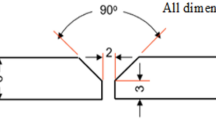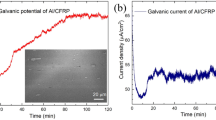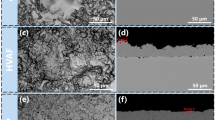Abstract
WELDING refractory ceramic oxides to a range of transition metals in oxidising atmospheres may involve two apparently distinct bonding mechanisms1,2. In type 1 bonds, which involve the noble metals, a sharp phase discontinuity at the metal–ceramic interface is maintained, even after prolonged annealing in oxygen. No intermediate oxide phase, other than the original ceramic, is observed. The substantial bond strengths3 reach their maximum value after a few hours and do not deteriorate with time. Residual thermal stresses are small as shown by high resolution hot-stage electron microscopy4. In contrast, in type 2 bonds, in which the more reactive transition metals are used, an intermediate (quaternary) oxide layer is clearly visible, its thickness growing with time. The bond strength depends on the corrosion behaviour of the metal and the mechanical strength of the intermediate oxide layer, as metal cations diffuse by bulk and grain boundaries into the ceramic. It is influenced by the duration of the anneal, as the oxidation process continues. Here we report the experimental observation that the couples Pd/MgO and Pd/Al2O3 form type 2 bonds below 800 °C and strong type 1 bonds above that temperature, when annealed in air.
This is a preview of subscription content, access via your institution
Access options
Subscribe to this journal
Receive 51 print issues and online access
$199.00 per year
only $3.90 per issue
Buy this article
- Purchase on Springer Link
- Instant access to full article PDF
Prices may be subject to local taxes which are calculated during checkout
Similar content being viewed by others
References
de Bruin, H. J., Moodie, A. F. & Warble, C. E. J. Mater. Sci. 7, 909–918 (1972).
de Bruin, H. J., Moodie, A. F. & Warble, C. E. J. Aust. ceram. Soc. 7, 57–58 (1971).
Bailey, F. P. & Black, K. T. J. Mater. Sci. (in the press).
Lugton, F. D. & Warble, C. E. Rev. Scient. Instrum. 41, 1793–1797 (1970).
Hondros, E. D. in Interfaces Conf. Melbourne 1969 (ed. Gifkins, R. C.) 77–100 (The Australian Institute of Metals and Butterworths, Sydney, 1969).
McClean, M. & Hondros, E. D. J. Mater. Sci. 6, 19–24 (1971).
Shannon, R. D., Rogers, D. B. & Prewitt, C. T. Inorg. Chem. 10, 713–718 (1971).
Schouler, E., Kleitz, M. & Deportes, C. J. chim. Phys. 70, 923–935 (1973).
Perfil'ev, M. V. & Pal'guev, S. F. in Electrochemistry of Molten and Solid Electrolytes (ed. Baraboshkin, A. N.) 4, 153–157 (Consultants Bureau, New York, 1967).
Gupta, D. Thin Solid Films 25, 231–244 (1975).
d'Heurle, F. M. & Rosenburg, R. Phys. Thin Films 7, 257–310 (1975).
Harris, L. A., Gerstner, M. E. & Wilson, R. H. General Electric Technical Information Series No. 77 CRD103 (1977).
Kubaschewski, O., Evans, E. D. & Alcock, C. B. Metallurgical Thermochemistry 4th edn (Pergamon, Oxford, 1967).
Steele, B. C. H. in Electromotive Force Measurements in High Temperature Systems (ed. Alcock, C. B.) (Institution of Mining and Metallurgy, London, 1968).
Author information
Authors and Affiliations
Rights and permissions
About this article
Cite this article
DE BRUIN, H. Interfacial noble-metal corrosion in metal to ceramic reaction welding. Nature 272, 712–713 (1978). https://doi.org/10.1038/272712a0
Received:
Accepted:
Issue Date:
DOI: https://doi.org/10.1038/272712a0
This article is cited by
-
Effect of oxygen on the wettability of sapphire by liquid palladium
Journal of Materials Science (1996)
Comments
By submitting a comment you agree to abide by our Terms and Community Guidelines. If you find something abusive or that does not comply with our terms or guidelines please flag it as inappropriate.



